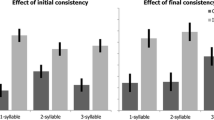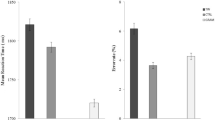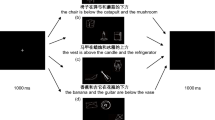Abstract
In this study participants were asked to describe pictured events in one type-written sentence, containing one of two different syntactic structures (subordinated vs. coordinated subject noun phrases). According to the hypothesis, the larger subordinated structure (one noun phrase including a second, subordinated, one) should be cognitively more costly and will be planned before the start of the production, whereas the coordinated structure, consisting of two syntactically equal noun phrases, can be planned locally in an incremental fashion. The hypothesis was confirmed by the analysis of the word-initial keystroke latencies as well as the eye movements towards the stimulus, indicating a stronger tendency to incremental planning in case of the coordinated structure.






Similar content being viewed by others
Notes
In case of word-initial characters, the preceding character is always the space key.
Every character has a width of 11 px. The first character starts 64 px from the left. If a fixation on the text has an x-value of e.g., 121 one can infer that the 5th character has been fixated. The letter being in the 5th position can be matched from the keyboard data.
References
Alamargot, D., Chesnet, D., Dansac, C., & Ros, S. (2006). Eye and pen: A new device for studying reading during writing. Behavior Research Methods Instruments & Computers, 38, 287–299.
Alamargot, D., Dansac, C., Ros, S., & Chuy, M. (2005). Rédiger un texte procédural à partir de sources: Relations entre l’empan de production écrite et l’activité oculaire du scripteur [Revising a prodecural text from sources: Relations between the written production span and the writer’s eye movements]. In D. Alamargot, P. Terrier, & J.-M. Cellier (Eds.), Production, compréhension et usages des écrits techniques au travail [Production, comprehension and usage of technical writing at the workplace] (pp. 51–68). Toulouse, France: Octares Editions.
Andersson, B., Dahl, J., Holmqvist, K., Holsanova, J., Johansson, V., & Karlsson, H. (2006). Combining keystroke logging with eye-tracking. In L. van Waes, M. Leijten, C. M. Neuwirth, et al. (Eds.), Writing and digital media (Studies in writing) (Vol. 17, pp. 166–172). Amsterdam: Elsevier.
Barr, D. J. (2008). Analyzing ‘visual world’ eyetracking data using multilevel logistic regression. Journal of Memory and Language, 59, 457–474.
Chanquoy, L., Foulin, J.-N., & Fayol, M. (1990). Temporal management of short text writing by children and adults. Cahiers de Psychologie Cognitive, 10, 513–540.
Chanquoy, L., Foulin, J.-N., & Fayol, M. (1995). Writing in adults: A real-time approach. In G. Rijlaarsdam, H. Van den Bergh, & M. Couzijn (Eds.), Theories, models and methodology: Current trends in research on writing (pp. 36–44). Amsterdam: Amsterdam University Press.
Cooper, W. E. (Ed.). (1983). Cognitive aspects of skilled typewriting. New York, Heidelberg, Berlin: Springer.
Coover, J. E. (1923). A method of teaching typewriting based upon a psychological analysis of expert typing. National Education Association, 61, 561–567.
Dvorak, A., Merrick, N. L., Dealey, W. L., & Ford, G. C. (1936). Typewriting behavior. New York: American Book Company.
Fendrick, P. (1937). Hierarchical skills in typewriting. Journal of Educational Psychology, 28, 609–620.
Foulin, J.-N. (1998). To what extent does pause location predict pause duration in adults’ and children’s writing? Cahiers de Psychologie Cognitive, 17, 601–620.
Gentner, D. R. (1982). Evidence against a central control model of timing in typing. Journal of Experimental Psychology: Human Perception and Performance, 8, 793–810.
Gentner, D. R. (1983). The acquisition of typewriting skill. Acta Psychologica, 54, 233–248.
Gentner, D. R., Larochelle, S., & Grudin, J. T. (1988). Lexical, sublexical, and peripheral effects in skilled typewriting. Cognitive Psychology, 20, 524–548.
Goldman-Eisler, F. (1972). Pauses, clauses, sentences. Language and Speech, 15, 103–113.
Griffin, Z. M. (2001). Gaze durations during speech reflect word selection and phonological encoding. Cognition, 82, B1–B14.
Griffin, Z. M., & Bock, K. (2000). What the eyes say about speaking. Psychological Science, 11, 274–279.
Inhoff, A. W., Briihl, D., Bohemier, G., & Wann, J. P. (1992a). Eye-hand span and coding of text during copytyping. Journal of Experimental Psychology: Learning, Memory, and Cognition, 18, 298–306.
Inhoff, A. W., & Gordon, A. M. (1998). Eye movements and eye-hand coordination during typing. Current Directions in Psychological Science, 6, 153–157.
Inhoff, A. W., & Jian, W. (1992). Encoding of text, manual movement planning, and eye-hand coordination during copytyping. Journal of Experimental Psychology: Human Perception and Performance, 18, 437–448.
Inhoff, A. W., Topolski, R., & Wann, J. P. (1992b). Saccade programming during short duration fixations—an examination of copytyping, letter detection, and reading. Acta Psychologica, 81, 1–21.
Johansson, R., Wengelin, Å., Johansson, V., & Holmqvist, K. (2009). Gazing at the keyboard or the monitor: The relation to text production processes. Reading & Writing: An Interdisciplinary Journal (this issue).
Johnson, R. L., Perea, M., & Rayner, K. (2007). Transposed-letter effects in reading: Evidence from eye movements and parafoveal preview. Journal of Experimental Psychology: Human Perception and Performance, 33, 209–229.
Kempen, G., & Huijbers, P. (1983). The lexicalization process in sentence production and naming: Indirect selection of words. Cognition, 14, 185–209.
Larochelle, S. (1983). A comparison of skilled and novice performance in discontinuous typing. In W. E. Cooper (Ed.), Cognitive aspects of skilled typewriting (pp. 67–94). New York, Heidelberg, Berlin: Springer.
Leijten, M. (2007). Writing and speech recognition: Observing error correction strategies of professional writers. LOT Dissertation Series: Vol. 160: LOT.
Levelt, W. J. M., & Maassen, B. (1981). Lexical search and order of mention in sentence production. In W. Klein, W. J. M. Levelt, & M. Bierwisch (Eds.), Crossing the boundaries in linguistics. Studies presented to Manfred Bierwisch (Synthese language library) (Vol. 13, pp. 221–252). Dordrecht, The Netherlands: Reidel.
Massaro, D. W., & Lucas, P. A. (1984). Typing letter strings varying in orthographic structure. Acta Psychologica, 57, 109–131.
Matsuhashi, A. (1981). Pausing and planning: The tempo of written discourse production. Research in the teaching of English, 15, 113–134.
Matsuhashi, A. (1982). Explorations in the real time production of written discourse. In M. Nystrand (Ed.), What writers know: The language, process and structure of written discourse (pp. 269–289). New York: Academic Press.
Matsuhashi, A. (1987). Revising the plan and altering the text. In A. Matsuhashi (Ed.), Writing research: Writing in real time. Modelling production processes (pp. 197–223). Norwood, NJ: Ablex.
Meyer, A. S. (1996). Lexical access in phrase and sentence production: Results from picture—word interference tasks. Journal of Memory and Language, 35, 477–496.
Meyer, A. S., Sleiderink, A. M., & Levelt, W. J. M. (1998). Viewing and naming objects: Eye movements during noun phrase production. Cognition, 66, B25–B33.
Meyer, A. S., & Van der Meulen, F. F. (2000). Phonological priming effects on speech onset latencies and viewing times in object naming. Psychonomic Bulletin & Review, 7, 314–319.
Nottbusch, G. (2008). Handschriftliche sprachproduktion—sprachstrukturelle und ontogenetische aspekte. [Analysis of children’s handwriting movements. Orthographic and developmental aspects]. Tübingen, Germany: Niemeyer.
Nottbusch, G., Grimm, A., Weingarten, R., & Will, U. (2005). Syllabic structures in typing: Evidence from hearing impaired writers. Reading & Writing: An Interdisciplinary Journal, 18, 497–526.
Nottbusch, G., Weingarten, R., & Sahel, S. (2007). From written word to written sentence production. In M. Torrance, L. van Waes, & D. W. Galbraith (Eds.), Writing and cognition. Research and applications (Studies in writing) (Vol. 20, pp. 31–53). Amsterdam: Elsevier.
Ostry, D. J. (1983). Determinants of interkey times in typing. In W. E. Cooper (Ed.), Cognitive aspects of skilled typewriting (pp. 225–246). New York, Heidelberg, Berlin: Springer.
Rumelhart, D. E., & Norman, D. A. (1982). Simulating a skilled typist: A study of skilled cognitive-motor performance. Cognitive Science, 6, 1–36.
Sahel, S., Nottbusch, G., Grimm, A., & Weingarten, R. (2008). The impact of frequency and semantic transparency on the time course of German compound production. Written Language and Literacy, 11, 221–228.
Sahel, S., Nottbusch, G., Weingarten, R., & Blanken, G. (2005). The role of phonology and syllabic structure in the time course of typing: Evidence from aphasia. Linguistische Berichte, 201, 65–87.
Schilperoord, J. (2002). On the cognitive status of pauses in discourse production. In T. Olive & C. M. Levy (Eds.), Contemporary tools and techniques for studying writing (Studies in writing) (Vol. 10, pp. 61–88). Dordrecht, Boston: Kluwer Academic Publishers.
Schriefers, H., & Teruel, E. (1999). The production of noun phrases: A cross-linguistic comparison of French and German. In M. Hahn & S. C. Stoness (Eds.), Proceedings of the Twenty-First Annual Conference of the Cognitive Science Society (pp. 637–642). August 19–21, 1999, Vancouver, British Columbia: Simon Fraser University. Mahwah, NJ: Erlbaum.
Shaffer, L. H. (1973). Latency mechanisms in transcription. In S. Kornblum (Ed.), Attention and performance IV (pp. 435–446). New York: Academic Press.
Shaffer, L. H. (1978). Timing in the motor programming of typing. Quarterly Journal of Experimental Psychology, 30, 333–345.
Shaffer, L. H., & Hardwick, J. (1968). Typing performance as a function of text. Quarterly Journal of Experimental Psychology, 20, 360–369.
Smith, M. C., & Wheeldon, L. R. (1999). High level processing scope in spoken sentence production. Cognition, 73, 205–246.
Sternberg, S., Monsell, S., Knoll, R. L., & Wright, C. E. (1978). Latency and duration of rapid movement sequences: Comparison of speech and typewriting. In G. E. Stelmach (Ed.), Information processing in motor control and learning (pp. 117–152). New York: Academic Press.
Sullivan, K. P. H., & Lindgren, E. (Eds.). (2006). Computer key-stroke logging and writing: Methods and applications (Vol. 19). Amsterdam: Elsevier Science.
Terzuolo, C. A., & Viviani, P. (1980). Determinants and characteristics of motor patterns used for typing. Neuroscience, 5, 1085–1103.
Van Waes, L., Leijten, M., & Quinlan, T. (2009). Reading during sentence composing and error correction: A multilevel analysis of the influences of cognitive load and error type. Reading & Writing: An Interdisciplinary Journal (this issue).
Viviani, P., & Laissard, G. (1996). Motor templates in typing. Journal of Experimental Psychology: Human Perception and Performance, 22, 417–445.
Weingarten, R., Nottbusch, G., & Will, U. (2004). Morphemes, syllables, and graphemes in written word production. In T. Pechmann & C. Habel (Eds.), Multidisciplinary approaches to language production (pp. 529–572). Berlin: Mouton de Gruyter.
Wengelin, Å., Torrance, M., Holmqvist, K., Simpson, S., Galbraith, D. W., & Johansson, V. (2009). Combined eye-tracking and keystroke-logging methods for studying cognitive processes in text production. Behavior Research Methods, 41, 337–351.
Will, U., Nottbusch, G., & Weingarten, R. (2006). Linguistic units in word typing: Effects of word presentation modes and typing delay. Written Language and Literacy, 9, 156–173.
Zesiger, P., Orliaguet, J.-P., Boë, L.-J., & Mounoud, P. (1994). The influence of syllabic structure in handwriting and typing production. In C. Faure, P. Keuss, G. Lorette, & A. Vinter (Eds.), Advances in handwriting and drawing. A multidisciplinary approach (pp. 389–401). Paris: Europia.
Author information
Authors and Affiliations
Corresponding author
Rights and permissions
About this article
Cite this article
Nottbusch, G. Grammatical planning, execution, and control in written sentence production. Read Writ 23, 777–801 (2010). https://doi.org/10.1007/s11145-009-9188-4
Received:
Accepted:
Published:
Issue Date:
DOI: https://doi.org/10.1007/s11145-009-9188-4




